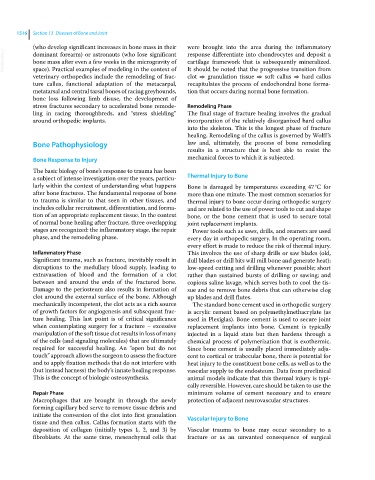Page 1578 - Clinical Small Animal Internal Medicine
P. 1578
1516 Section 13 Diseases of Bone and Joint
(who develop significant increases in bone mass in their were brought into the area during the inflammatory
VetBooks.ir dominant forearm) or astronauts (who lose significant response differentiate into chondrocytes and deposit a
cartilage framework that is subsequently mineralized.
bone mass after even a few weeks in the microgravity of
space). Practical examples of modeling in the context of
clot ⇒ granulation tissue ⇒ soft callus ⇒ hard callus
veterinary orthopedics include the remodeling of frac- It should be noted that the progressive transition from
ture callus, functional adaptation of the metacarpal, recapitulates the process of endochondral bone forma-
metatarsal and central tarsal bones of racing greyhounds, tion that occurs during normal bone formation.
bone loss following limb disuse, the development of
stress fractures secondary to accelerated bone remode- Remodeling Phase
ling in racing thoroughbreds, and “stress shielding” The final stage of fracture healing involves the gradual
around orthopedic implants. incorporation of the relatively disorganized hard callus
into the skeleton. This is the longest phase of fracture
healing. Remodeling of the callus is governed by Wolff’s
Bone Pathophysiology law and, ultimately, the process of bone remodeling
results in a structure that is best able to resist the
Bone Response to Injury mechanical forces to which it is subjected.
The basic biology of bone’s response to trauma has been
a subject of intense investigation over the years, particu- Thermal Injury to Bone
larly within the context of understanding what happens Bone is damaged by temperatures exceeding 47 °C for
after bone fractures. The fundamental response of bone more than one minute. The most common scenarios for
to trauma is similar to that seen in other tissues, and thermal injury to bone occur during orthopedic surgery
includes cellular recruitment, differentiation, and forma- and are related to the use of power tools to cut and shape
tion of an appropriate replacement tissue. In the context bone, or the bone cement that is used to secure total
of normal bone healing after fracture, three overlapping joint replacement implants.
stages are recognized: the inflammatory stage, the repair Power tools such as saws, drills, and reamers are used
phase, and the remodeling phase. every day in orthopedic surgery. In the operating room,
every effort is made to reduce the risk of thermal injury.
Inflammatory Phase This involves the use of sharp drills or saw blades (old,
Significant trauma, such as fracture, inevitably result in dull blades or drill bits will mill bone and generate heat);
disruptions to the medullary blood supply, leading to low‐speed cutting and drilling whenever possible; short
extravasation of blood and the formation of a clot rather than sustained bursts of drilling or sawing; and
between and around the ends of the fractured bone. copious saline lavage, which serves both to cool the tis-
Damage to the periosteum also results in formation of sue and to remove bone debris that can otherwise clog
clot around the external surface of the bone. Although up blades and drill flutes.
mechanically incompetent, the clot acts as a rich source The standard bone cement used in orthopedic surgery
of growth factors for angiogenesis and subsequent frac- is acrylic cement based on polymethylmethacrylate (as
ture healing. This last point is of critical significance used in Plexiglas). Bone cement is used to secure joint
when contemplating surgery for a fracture – excessive replacement implants into bone. Cement is typically
manipulation of the soft tissue clot results in loss of many injected in a liquid state but then hardens through a
of the cells (and signaling molecules) that are ultimately chemical process of polymerization that is exothermic.
required for successful healing. An “open but do not Since bone cement is usually placed immediately adja-
touch” approach allows the surgeon to assess the fracture cent to cortical or trabecular bone, there is potential for
and to apply fixation methods that do not interfere with heat injury to the constituent bone cells, as well as to the
(but instead harness) the body’s innate healing response. vascular supply to the endosteum. Data from preclinical
This is the concept of biologic osteosynthesis. animal models indicate that this thermal injury is typi-
cally reversible. However, care should be taken to use the
Repair Phase minimum volume of cement necessary and to ensure
Macrophages that are brought in through the newly protection of adjacent neurovascular structures.
forming capillary bed serve to remove tissue debris and
initiate the conversion of the clot into first granulation Vascular Injury to Bone
tissue and then callus. Callus formation starts with the
deposition of collagen (initially types 1, 2, and 3) by Vascular trauma to bone may occur secondary to a
fibroblasts. At the same time, mesenchymal cells that fracture or as an unwanted consequence of surgical

